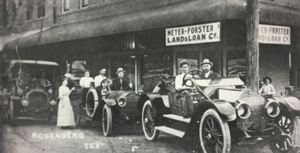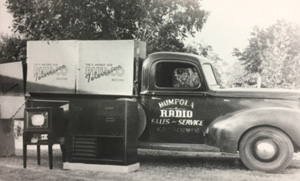A LITTLE PIECE OF HISTORY | By Joan Frances –

The Meyer-Forster-Mulcahy Building was constructed in 1910. Prospective customers are seen outside the building. Forster Land & Loan Company, a real estate developer, was owned by H.A. Meyer, president, and Fritz Forster, one of five brothers who came from Germany in the mid-1800s. Among Fritz’s brothers was “Pa” Forester. Meyer also served as mayor of Rosenberg.
Photos from Images of America Historic Downtown Rosenberg.
We live in a productive society where focus is on spontaneous communication and traveling without delay. It is difficult to fathom the world without these options. In the early years of Fort Bend County, residents depended on personal engagements and prolonged travel time. Let us take a step back to reminisce on the history.
The native Americans and the Chinese were some of the first long distance communicators. They used smoke signals to generate puffs of smoke with a fire and a blanket to transmit news, signal danger, distress signals or gather people to a common area. Because of the flat terrain in Fort Bend County, these smoke signals were visible for many miles. This method of communicating was simple: sending one puff of smoke was usually a call to attention, sending two puffs was a sign that everything is okay and three puffs was notification that something was wrong.
Flag signals and blowing horns also communicated messages over distances. Writing has evolved from etchings in caves, to alphabets and later, paper writing. In the early days of Fort Bend County, writing confirmed verbal agreements, kept important details of people and estates, and some letters were thoughtful and romantic. As early as 1775, the United States Mail service enabled communication from across the country. Mail carriers traveled over difficult routes on foot, horseback and on waterways to deliver the mail. In 1869, when the railroads were operating, mail service became the most efficient way of communicating from state to state.
On March 10, 1876, the first voice traveled over a telephone line. Around 1883, talking telephones were installed in Fort Bend County, and conversation between neighbors, businesses and family members opened the line of communication like never before.
By the end of 1922, radio broadcasting came to the South Texas area. By 1950, six television stations were in operation in Texas, with three in the Dallas-Fort Worth area, two in San Antonio and one in Houston.

Delivery truck for Humpola’s Radio Sales and Service during the 1950s.
Transportation began with the help of Mother Nature. Boat passage has been a source of travel for as far back as 900,000 years. The Brazos River, running 840 miles across Texas to the mouth of the Gulf of Mexico, was the main passage to Lubbock, Graham, Waco, Temple, Belton, George-town, Round Rock, Bryan-College Station, Rosenberg, Richmond, Freeport and Galveston. The steam boat, invented in 1769, enabled travelers to move up and down the river at an average speed of five miles an hour.
The earliest settlers rode horses and pulled covered wagons filled with their precious cargo. When the railroad came to town, the residents of Fort Bend were able to travel anywhere the train went. Commerce paved the way for city growth as Rosenberg and Richmond became the hub for passenger pick-up and drop-off. The first “horseless” carriage came to Texas in 1899. At that time, automobiles were very expensive, often costing more than houses. The Maxwell sold for $1,400 and the more modest Ford Model C cost $650. The Ford Motor Company led the way by establishing an independent dealership network and before long, several outlets in the area sold cars.
Today, communication and travel are at our finger tips. Internet, cell phones, email and abundant travel options are a click away. The communication proficiencies our society worked so hard to achieve are now linked to social media and texting. Perhaps looking back at the long road to achieving interaction success, we will appreciate how far we have come and how we should never forget the value of one-on-one communication.